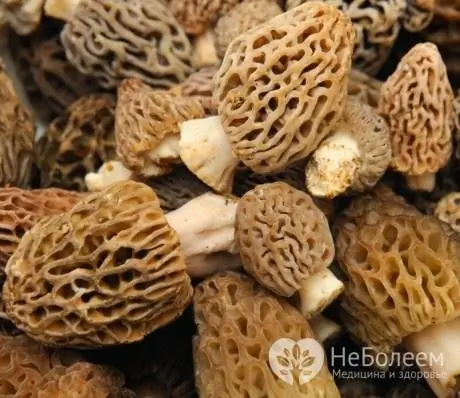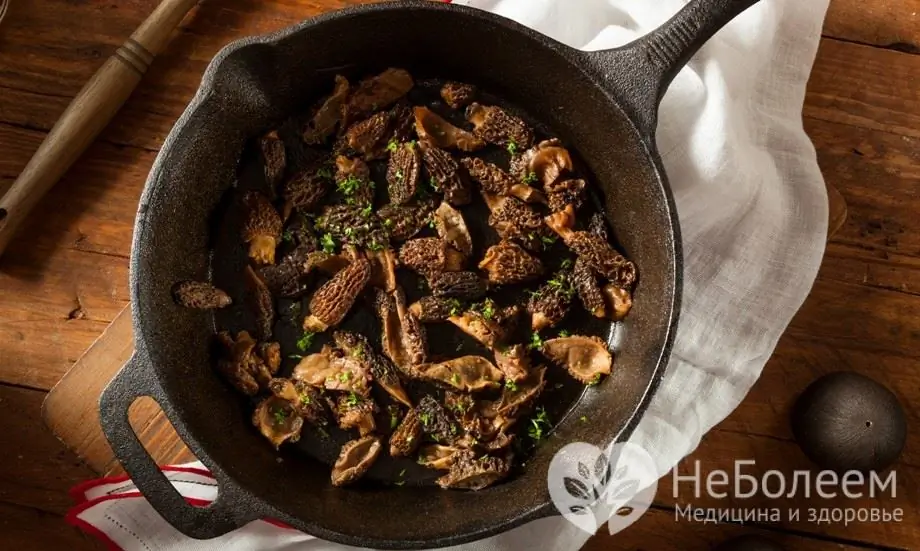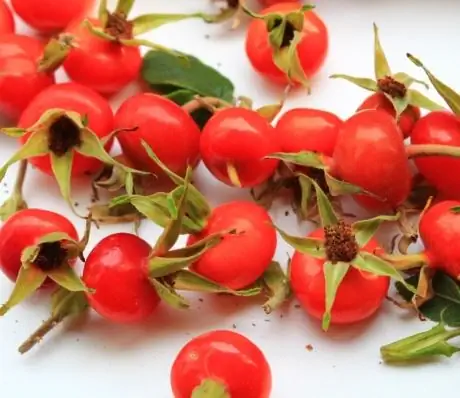- Author Rachel Wainwright [email protected].
- Public 2023-12-15 07:39.
- Last modified 2025-11-02 20:14.
Morel
Morel is a marsupial mushroom with a beautiful ovate-rounded cap, yellowish-brown in color and small cells that look like a honeycomb. The stem is hollow, cylindrical, several tones lighter than the cap. Morels have white flesh with a pleasant aroma and taste.
The ratio of BJU in the product

Source: depositphotos.com How to burn 31 kcal?
| Walking | 8 minutes |
| Jogging | 3 min. |
| Swimming | 3 min. |
| A bike | 4 minutes |
| Aerobics | 6 minutes |
| Household chores | 10 min. |
There are three types of morels in nature:
- Common or Edible (Morchella esculenta);
- Conical (Morchella conica);
- Cap or morel cap (Verpa bohemica Schroet).
The mushroom cap grows up to 10 centimeters in diameter and up to 15 centimeters in height. The leg can be up to 5 centimeters thick.
History and distribution
Morels are very ancient mushrooms. The first mention of them can be found in the works of Theophrastus, an ancient Greek scientist, dating back to the 4th century BC. In ancient Rome, these mushrooms were considered a delicacy, so the preparation of morels was not trusted by ordinary servants, but served to the table in the most expensive and exquisite dishes.
Until now, in many countries of the world, morels are treated with great respect. In America, for example, they carry the status of "royal mushrooms". Since the mid-19th century in France and Germany, they have been grown in gardens and parks under apple trees. In Russia, morels grow in the wild everywhere, hatching in late April - early May. They prefer mixed and deciduous forests, they like mossy ditches and edges, edges of fields and clearings, wastelands and old fires. In southern Russia, they can even be found on lawns, front gardens and vegetable gardens.
It was noticed that morels prefer not to grow in one and the same place, but botanists are still lost in conjecture how the mycelium of morels "moves" to another place, and sometimes completely disappears without a trace.
How to distinguish a false morel from a real one?
True morels are delicious edible mushrooms, but false morels are poisonous. Fortunately, they can be easily distinguished from each other. This is done by a longitudinal cut along the body of the mushroom. In the false morel, the cap is not tied to the stem, but the stem is wadded and dense, while in true mushrooms the stem is hollow, and the cap merges with it.
The use of morels in cooking
In Russia, morels are considered conditionally edible mushrooms and according to their taste data they are referred to the third category, despite the fact that in Europe they are considered to be a delicacy. In America, for example, at the annual banquet dedicated to the convention of American mycologists, boiled morels are served without fail.
Before use, this mushroom must be boiled, and the broth must be drained. Only then can you start cooking morels, stew them, fry or add to soup. Morels are especially tasty stewed or in sauces. As a separate dish, you can serve morels stewed with sour cream, you can also use them as a filling for pies. Morels are not salted or pickled, they are dried, and they are used for food only three months after drying. It should be noted that dried mushrooms absorb moisture, so they must be stored in a dry place in cardboard boxes or paper bags, otherwise they will become damp and moldy.
The use of morels in traditional medicine
Since ancient times, morels have been used to treat myopia and hyperopia, as well as rheumatism and various joint diseases. They are shown to strengthen the immune system.
For medicinal purposes, mushrooms are recommended to be consumed regularly for six months. Before use, the mushrooms are cleaned, soaked for one hour in water, after which they are boiled and washed under running water.

Composition and calorie content of morels
Fresh morels contain approximately 3% nitrogenous substances, many aromatic substances and 1% sugar. They contain a polysaccharide called FD4. 100 g of morels contains 2.9 g of proteins, 2 g of carbohydrates and 0.4 g of fat.
Its calorie content is about 23 kcal per 100 g of product.
Contraindications
Due to the high content of toxins, morels must be dried or boiled before cooking. When used correctly, there will be no harm to the body from fungi.
YouTube video related to the article:
Found a mistake in the text? Select it and press Ctrl + Enter.






